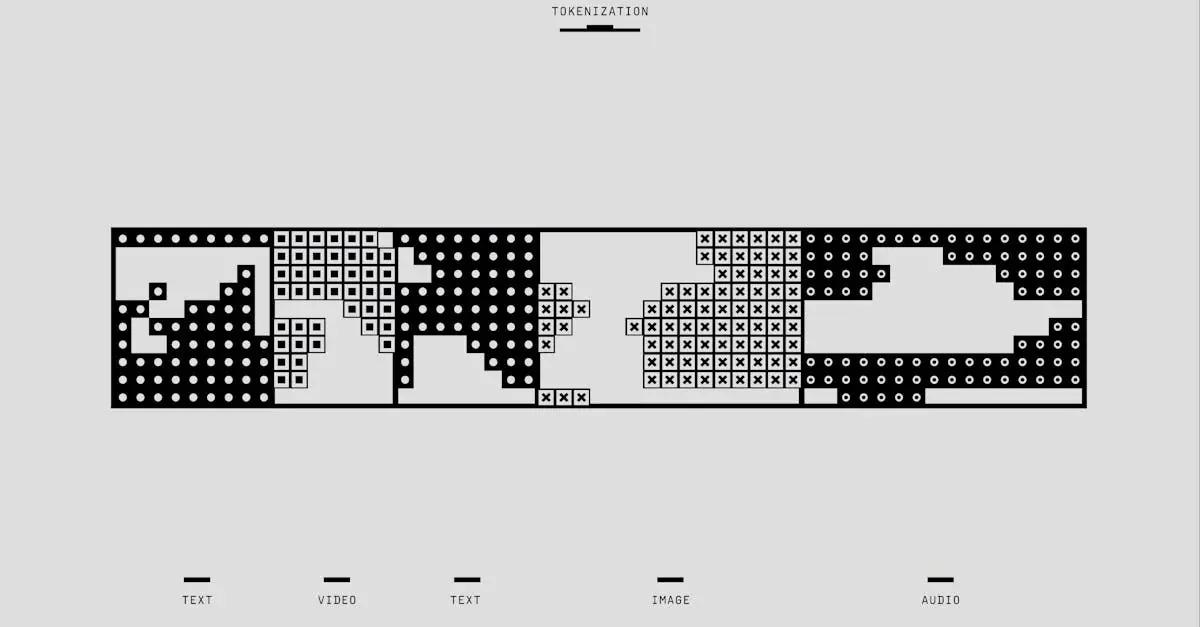In a world where digital transactions can feel as secure as a cat on a hot tin roof, blockchain code swoops in like a superhero. It’s the unsung hero of the tech universe, turning chaos into order with its decentralized charm. Imagine a ledger that’s not just safe but also transparent—sounds like a dream, right? Well, it’s time to wake up and smell the code.
Table of Contents
ToggleOverview of Blockchain Code
Blockchain code serves as the backbone of digital transaction systems. This code consists of smart contracts, consensus algorithms, and transaction scripts. Smart contracts autonomously execute commands when predefined conditions are met. Developers write these contracts in languages like Solidity for Ethereum and Viper to enable decentralized applications.
Consensus algorithms validate transactions across the network. Proof of Work (PoW) and Proof of Stake (PoS) represent popular mechanisms among various platforms. PoW requires computational power, whereas PoS relies on validators holding currency in a stake.
Transaction scripts manage the flow of information. Each transaction follows a defined format, ensuring all parties can verify it. These scripts maintain the integrity of transaction records, providing transparency and accountability.
Open-source nature allows for community development and scrutiny. Developers frequently collaborate to enhance security features and add functionalities. Their contributions lead to robust and resilient systems.
Error handling and efficiency are crucial within blockchain code. Proper diagnostic measures minimize disruptions during execution. Optimizing code reduces processing times, resulting in improved user experience.
Documentation plays a vital role in blockchain code. Clear, concise documentation helps developers understand functions, making adoption smoother. Resources created by the community, such as GitHub repositories, provide ongoing support.
Ultimately, blockchain code enables secure, transparent digital transactions, fostering trust in various industries. Its architectural framework underpins not just cryptocurrencies but also financial services, supply chain management, and beyond.
Key Components of Blockchain Code
Key components form the foundation of blockchain code, enabling secure and efficient transactions across various applications. Understanding these elements is crucial for leveraging blockchain technology effectively.
Smart Contracts
Smart contracts act as self-executing agreements with predefined rules encoded in blockchain. They automate processes by executing transactions when specified conditions are met. As a result, they reduce reliance on intermediaries, enhancing efficiency and trust. Developers often use languages like Solidity for Ethereum to create these contracts. Use cases include automated payments and decentralized applications (dApps). With transparency and immutability, smart contracts minimize disputes and bolster accountability, thereby attracting industries looking for innovative solutions.
Consensus Mechanisms
Consensus mechanisms play a vital role in validating transactions within a blockchain network. They ensure that all participants agree on the validity of transactions before they are added to the blockchain. Prominent examples include Proof of Work (PoW) and Proof of Stake (PoS). PoW requires computational effort from miners to solve complex problems, while PoS selects validators based on the amount of cryptocurrency they hold. Both methods enhance security and prevent malicious activities. By optimizing transaction verification, consensus mechanisms contribute to the overall functionality and reliability of blockchain technology.
Programming Languages for Blockchain Code
Various programming languages contribute significantly to blockchain development, each offering unique features and capabilities.
Solidity
Solidity stands out as the primary language for creating smart contracts on the Ethereum platform. This statically typed language emphasizes security and simplicity, allowing developers to write complex applications with concise syntax. Its widespread adoption means a robust developer community exists, providing resources and tools for effective coding. Additionally, Solidity’s integration with Ethereum’s ecosystem enables seamless interaction with decentralized applications. Developers appreciate its support for inheritance, libraries, and complex user-defined types, all of which enhance functionality in decentralized finance and various other applications.
Go
Go, also known as Golang, is designed for high performance and efficiency, making it a solid choice for blockchain projects. This language offers built-in concurrency features, allowing developers to execute multiple tasks simultaneously, which optimizes transaction processing. Its statically typed nature reduces runtime errors, contributing to more reliable code. Many major blockchain platforms, including Hyperledger Fabric, utilize Go, highlighting its scalability and ease of deployment. Moreover, Go’s simplicity combined with modern architectural principles facilitates a clear structure, promoting maintainability in complex codebases.
JavaScript
JavaScript plays a crucial role in developing blockchain applications, particularly in creating user interfaces for decentralized apps. Its versatility allows seamless integration with various frameworks and libraries, enhancing user experience. The language supports event-driven programming, which is essential for responsive and interactive applications. Many blockchain networks also provide JavaScript SDKs, enabling easy access to blockchain functionalities. With the rise of frameworks like Node.js, JavaScript developers can build server-side solutions, broadening the scope of blockchain development opportunities. This language continues to evolve, adapting to the needs of modern application development in the blockchain space.
Security Considerations in Blockchain Code
Security remains a crucial aspect of blockchain code development. Smart contracts must undergo rigorous testing to prevent vulnerabilities. Developers often utilize formal verification methods to mathematically prove the correctness of these contracts.
Consensus mechanisms help maintain the integrity of blockchain networks. Proof of Work and Proof of Stake play significant roles in ensuring that only legitimate transactions receive validation. These mechanisms also deter malicious actors from compromising the network.
Code reviews among peers enhance security. Engaging multiple developers in the review process allows for the identification of potential flaws that one individual may overlook. Peer review fosters a culture of collaboration, further strengthening the code’s resilience.
Documentation must not be neglected. Clear and comprehensive documentation supports future developers in understanding the codebase while reducing the chance of introducing errors during updates or modifications. Clarity in documentation also aids in ensuring compliance with regulatory standards.
Adopting best practices for error handling can prevent severe security breaches. Implementing fail-safes and fallback mechanisms allows systems to recover gracefully from unexpected issues. Comprehensive logging of events aids in identifying anomalies and responding appropriately.
Educating team members on security protocols is essential. Regular training sessions enable them to recognize threats, bolstering the security posture of the entire project. Creating a security-first mindset within the development team leads to stronger, more secure applications.
Finally, engaging with the broader community can reveal new security insights. Participating in forums, attending workshops, and collaborating on open-source projects can keep developers informed about emerging threats and solutions. Collective knowledge often leads to more robust security frameworks.
Real-World Applications of Blockchain Code
Blockchain code significantly impacts various sectors, providing solutions that enhance transparency and security. Financial services benefit from smart contracts, facilitating automated trade execution and reducing operational costs. In supply chain management, blockchain tracks products, ensuring provenance and authenticity at each stage.
Healthcare also experiences improvements through blockchain technology. Patient records stored on a blockchain allow for secure sharing among healthcare providers, enhancing data access while maintaining privacy. Legal industries utilize blockchain for document verification, ensuring authenticity and reducing the risk of fraud.
Real estate transactions experience transformation too. Smart contracts streamline property transfers, automating processes such as title transfers and payments. Professionals in the gaming industry use blockchain to verify in-game asset ownership and create unique digital collectibles, revolutionizing user experiences.
Government services deploy blockchain for voting systems, improving transparency and reducing fraud risks during elections. Public records management benefits from blockchain’s immutable nature, securing land registries and preventing unauthorized changes.
Cryptocurrencies exemplify the application of blockchain code, enabling secure peer-to-peer transactions. Diverse digital currencies, such as Bitcoin and Ethereum, illustrate the technology’s impact on the financial landscape.
In energy markets, blockchain enables peer-to-peer energy trading, allowing consumers to buy and sell excess energy with minimal intermediaries. Monetizing renewable energy sources becomes more efficient, contributing to sustainability initiatives.
Companies also embrace blockchain for loyalty programs, improving user engagement while streamlining reward redemption processes. Enhanced transparency fosters trust among consumers in industries like retail and hospitality.
Conclusion
Blockchain code represents a pivotal element in the evolution of digital transactions. Its ability to enhance security and transparency makes it a game changer across multiple industries. By leveraging smart contracts and consensus mechanisms, blockchain technology streamlines processes and builds trust among users.
As developers continue to innovate and refine blockchain applications, the potential for this technology will only grow. The commitment to rigorous testing and community collaboration will further strengthen its resilience against threats. With ongoing advancements, blockchain code is set to redefine how transactions are conducted, ensuring a more secure and efficient digital landscape.




